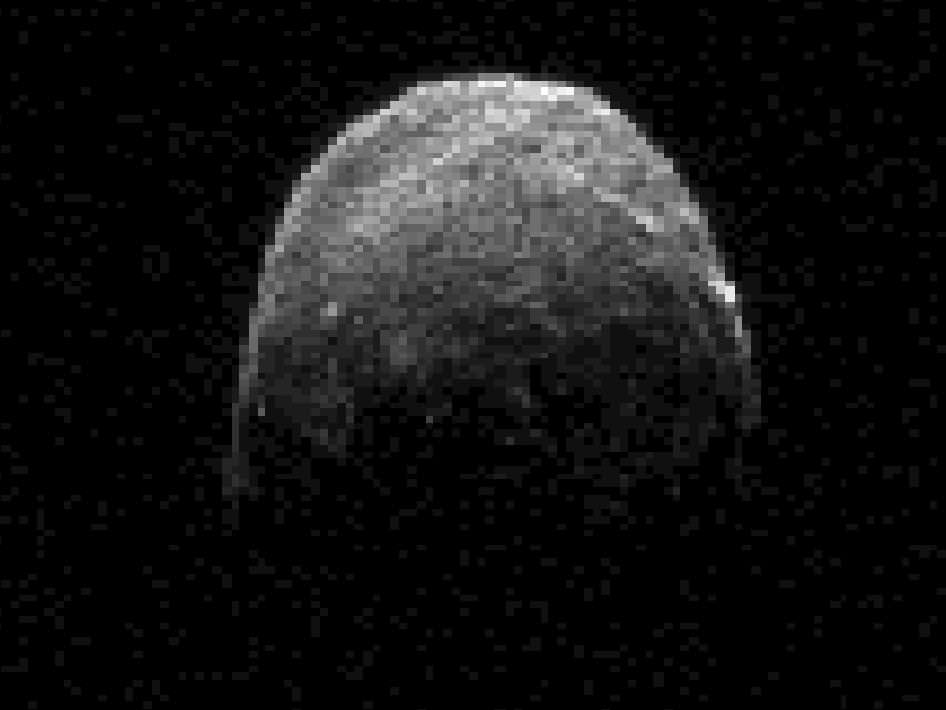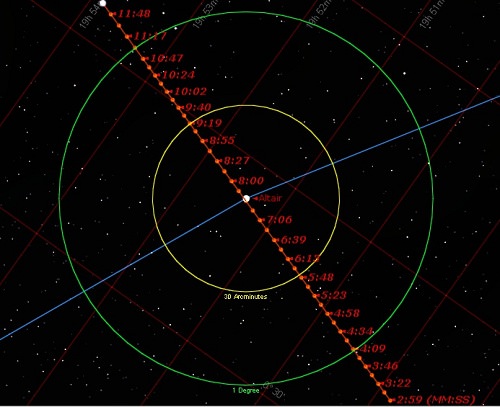Here’s a short movie of Asteroid 2005 YU55, created from data collected from the 70-meter Deep Space Network antenna at Goldstone, California. The video was generated from six frames, and each of the six frames required 20 minutes of radar data collection. They are the highest-resolution images ever generated by radar of a near-Earth object.
Continue reading “First Movie of Asteroid 2005 YU55’s Flyby”
Just In: NASA’s Latest Image of Asteroid 2005 YU55
[/caption]
NASA’s Deep Space Network antenna in Goldstone, California has captured new radar images of Asteroid 2005 YU55 as it begins its close pass by Earth. The image above was taken on Nov. 7 at 11:45 a.m. PST (2:45 p.m. EST/1945 UTC), when the asteroid was approximately 1.38 million kilometers (860,000 miles) or about 3.6 lunar distances away from Earth. It’s not a great image, but there should be better images available as the asteroid gets closer. Several telescopes will be tracking of the aircraft carrier-sized asteroid throughout the pass. Goldstone’s 230-foot-wide (70-meter) antenna has been keeping an eye on it since Nov. 4, and the Arecibo Planetary Radar Facility in Puerto Rico will begin observations on Nov. 8, as the asteroid will make its closest approach to Earth at 3:28 p.m. PST (6:28 p.m. EST/1128 UTC).
The Slooh telescope will be hosting a live webcast of the flyby on Nov. 8, 2011. Find out more at the Slooh Events page. Keep track of the latest images gathered by astronomers at the Asteroid and Comet Watch website.
Source: NASA
Hoping to See Asteroid 2005 YU55? There’s an App for That!
Starmap is an astronomy/planetarium app for the iPhone and iPad. A companion app, called Spacemap is an extended orrery that lets you view the phases, motions, and positions of items in the Universe all from your iPad. If you’re hoping to track down Asteroid 2005 YU55 as it comes close to Earth on Nov. 8, you might want to check out both Starmap and Starmap. You can see this asteroid in both apps, but Spacemap is the only application available in the iTunes store that displays 2005 YU55’s orbit in 3D animation.
UPDATE: The contest is now closed and the winners have been notified.
Want to win a copy of either Starmap or Spacemap? Universe Today has a two copies of each to give away to the first four readers to answer this question correctly: What year was the last time an asteroid as big as 2005 YU55 passed by Earth?
Answer in the comment section, and indicate which app you’d like. We have two of each to give away. First four commenters to answer correctly wins. Make sure your contact info on Disqus is correct, as that is you’ll be contacted.
Continue reading “Hoping to See Asteroid 2005 YU55? There’s an App for That!”
Asteroid 2005 YU55: See It For Yourself!
[/caption]
It’s already been stated several times here on Universe Today that 2005 YU55, a 400-meter-wide roughly spherical asteroid, will not pose any threat to Earth as it passes by on Tuesday, November 8… even though it will come within 80% of the distance to the Moon. Many experts have come forward to state this fact, including Don Yeomans of JPL’s Near-Earth Object Observation Program and Lance Benner, a radio astronomer with the Deep Space Network in Goldstone, CA. But it will still be a notable event, being the first time since 1976 such a large object will pass so closely by our planet. So, with the eve of YU55’s approach upon us, let’s turn our curiosity toward another aspect of this cosmic visitation: how can we see it?
Unfortunately there are a couple of factors working against the casual observer being able to witness YU55’s pass. One: it’s a dark object. A very dark object. 2005 YU55 is a C-type asteroid, which means it is composed of carbonaceous material and is thus effectively darker than coal, reflecting less than 1% of the sunlight that it receives. It probably won’t be brighter than magnitude 10. (On the backwards-ranked scale of apparent magnitude, 6 is the limit of best visibility to the average human eye, while -1 or 0 would be a very bright star. Jupiter is about -3 right now, while the full moon would be -12.7. In a typical suburban neighborhood 3 or 4 is the limit of naked-eye visibility.)
And two: the Moon will be close to full on the night of the 8th, and YU55 will be headed in its direction. That sure won’t help visibility.
But, should you be located in a dark area, and should you have a 6″ or larger telescope at your disposal, you may want to give a go at spotting the asteroid that’s caused quite a fuss over the past few months for yourself. It won’t be a simple task, but it’s not impossible – and to help you out teacher, writer and astronomy enthusiast David Dickinson has posted an article about it on his blog, Astro Guyz.
Here’s an exerpt:
Closest approach to Earth occurs at 11:29 UTC/06:29 EST at about 202,000 miles distant, placing it high to the southwest for observers on the US Eastern Seaboard. At its closest approach, 2005 YU55 will glide along at one degree every 7 minutes, easily noticeable after a few minutes of observation at low power. I plan to target selected areas with my GOTO mount, sketch the field, then watch for changes. I may also take some wide-field piggyback stills with the DSLR, but mostly, this one will just be fun to watch.
Visually tracking a Near-Earth asteroid can be thrilling to watch; for example, I’ve actually seen 4179 Toutatis years ago show discernable movement after tracking it for a few moments in the eyepiece!
– David Dickinson
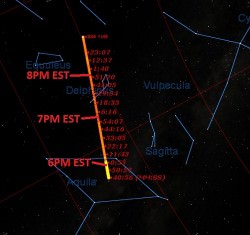
The asteroid will pass through the constellations Aquila, Delphinus, and Pegasus as it heads westward. Interestingly, 2005 YU55 passes within a degree of Altair centered on 6:07:30PM EST only 27 minutes after local sunset, and also makes a very close pass of the star Epsilon Delphini during closest approach. These both make good visual “anchors” to aim your scope at during the appointed time and watch. Keep in mind, the charts provided are rough and “Tampa Bay-centric…”
On an approach as close as this one, two factors muddle the precise prediction coordinates of the asteroid; one is the fact the gravitational field of the Earth will change the orbit of 2005 YU55 slightly, and two is that the position will change due to the position of the observer on the Earth and the effect of parallactic shift. Many prediction programs assume the Earthly vantage as a mere point in space, fine for positioning deep sky objects but not so hot for ones passing near the planet. A good place to get updated coordinates is JPL Horizons website which lets you generate an accurate ephemeris for your exact longitude latitude and elevation.
David goes on to add:
2005 YU55 will pass our Moon at 8 AM Universal Time on November 9th at a distance only marginally closer than it did the Earth, at 140,000 miles. Interestingly, it also transited Sun on November 3rd as seen from the Moon, but would have appeared <1” in size, a tough target for any would-be lunar-based observer. Its next close predicted passage of the Earth won’t be until 2056 at nearly 3 times the distance.
__________
Excellent information… many thanks to David for sharing with us! (You can read the full article on his website here.) And if you do witness the pass of this asteroid and somehow manage to get some photos of it, you can share them on the Universe Today Flickr group… they may be featured in an upcoming article!
Read more about 2005 YU55’s close pass by Earth tomorrow.
Charts and excerpts by David Dickinson, created with Starry Night and Paint.
Asteroid 2005 YU55: An Expert’s Explanation
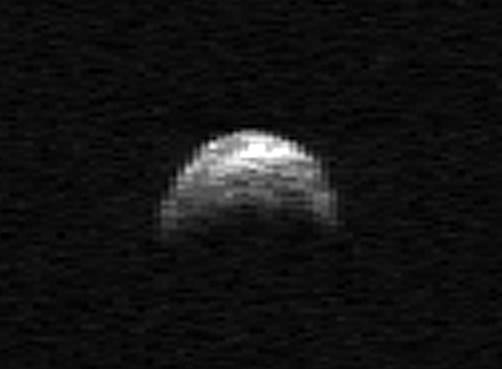
NASA’s Jet Propulsion Laboratory released this video today featuring more information about the much-discussed 2005 YU55, a 400-meter-wide asteroid that will pass by Earth next Tuesday at a distance closer than the Moon. The video features research scientist Lance Benner, an expert in radio imaging of near-Earth objects.
While YU55 will come closer than any object we’ve been aware of in the past 35 years, it poses no risk to Earth.
“2005 YU55 cannot hit Earth, at least over the interval that we can compute the motion reliably, which extends for several hundred years.”
– Lance Benner, JPL Research Scientist
[/caption]
While we can’t state enough that there’s no danger from YU55, this close pass will offer a fantastic opportunity for scientists to acquire detailed radar images of this ancient C-type asteroid.
NASA’s Near-Earth Objects Observation Program will continue tracking YU55 using the 70-meter radar telescope at the Deep Space Network in Goldstone, California, as well as with the Arecibo Planetary Radar Facility in Puerto Rico.
“This is the closest approach by an asteroid this large that we’ve known about in advance,” said Benner. “The Goldstone telescope has a new radar imaging capability which has just become available that will enable us to see much finer detail than has previously been possible.”
Radar imaging allows scientists to better study the surface features and composition of fast-moving, dark objects like YU55 which reflect very little visible light.
Space.com has provided a great infographic that shows exactly where this asteroid will pass by Earth. Note that the side view plainly shows that the path of the asteroid is well above the plane of the Earth/Moon orbit.
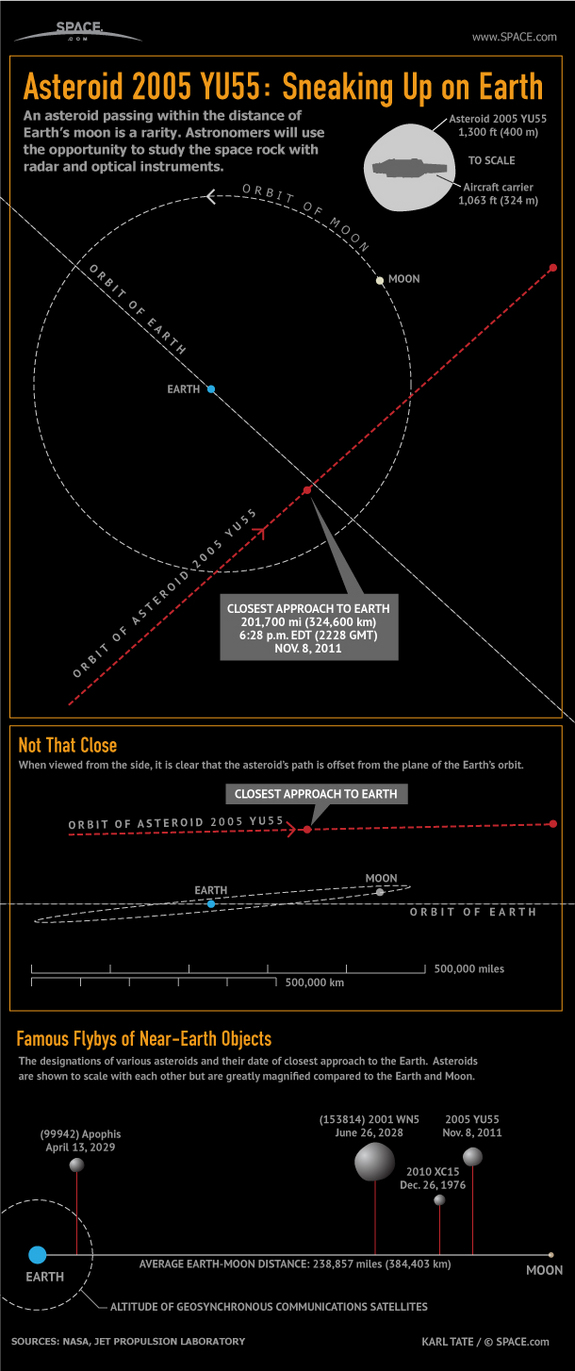
Source: SPACE.com: All about our solar system, outer space and exploration
Video: JPL
Asteroid 2005 YU55 Gets Closer to Earth; “No Chance of an Impact”

[/caption]
Yes, it’s coming. Yes, it’s big. Yes, it will be even closer than the Moon. And yes… we’re completely safe.
The 400-meter-wide asteroid 2005 YU55 is currently zipping through the inner Solar System at over 13 km (8 miles) a second. On Tuesday, November 8, at 6:28 p.m. EST, it will pass Earth, coming within 325,000 km (202,000 miles). This is indeed within the Moon’s orbit (although YU55’s trajectory puts it a bit above the exact plane of the Earth-Moon alignment.) Still, it is the closest pass by such a large object since 1976… yet, NASA scientists aren’t concerned. Why?
Because its orbit has been well studied, there’s nothing in its way, and frankly there’s simply nothing it will do to affect Earth.

Period.
2005 YU55’s miniscule gravity will not cause earthquakes. It has no magnetic field. It will not strike another object, or the Moon, or the Earth. It will not come into contact with cometary debris, Elenin, a black dwarf, Planet X, or Nibiru. (Not that those last three even exist.) No, YU55 will do exactly what it’s doing right now: passing through the Solar System. It will come, it will go, and hopefully NASA scientists – as well as many amateur astronomers worldwide – will have a chance to get a good look at it as it passes.
Scientists with NASA’s Near-Earth Objects Observation Program will begin tracking YU55 on Friday, November 4 using the 70-meter radar telescope at the Deep Space Network in Goldstone, California , as well as with the Arecibo Planetary Radar Facility in Puerto Rico beginning November 8. These facilities will continue to track it until the 10th.
This close pass will offer a great opportunity to get detailed radar imaging of YU55, an ancient C-type asteroid literally darker than coal. Since these objects can be difficult to observe using visible light, radar mapping can better reveal details about their surface and composition.
To help inform the public about YU55 NASA’s Jet Propulsion Laboratory in Pasadena recently hosted a live Q&A session on Ustream featuring specialists Marina Brozovic, a Goldstone Radar Team scientist, and Don Yeomans, manager of NASA’s Near-Earth Object Program. They fielded questions sent in via chat and Twitter… a recording of the event in its entirety can be seen below:
Undoubtedly there will still be those who continue to spread misinformation about 2005 YU55. After all, they did the same with the now-disintegrated comet Elenin. But the truth is out there… and the truth is that there’s no danger, no cover-ups, no “plots”, and simply no cause for concern.
“It’s completely safe… no chance of an impact.”
– Don Yeomans, JPL
Read more about YU55 on our previous post or on NASA’s Near-Earth Object Program site.
UPDATE: JPL has released a brief video about YU55 featuring research scientist Lance Benner, who specializes in radar imaging of near-Earth objects:
Although classified as a potentially hazardous object, 2005 YU55 poses no threat of an Earth collision over at least the next 100 years. However, this will be the closest approach to date by an object this large that we know about in advance and an event of this type will not happen again until 2028 when asteroid (153814) 2001 WN5 will pass to within 0.6 lunar distances. – Near-Earth Object Program, JPL
Phobos and Jupiter Conjunction in 3 D and Amazing Animation – Blastoff to Martian Moon near
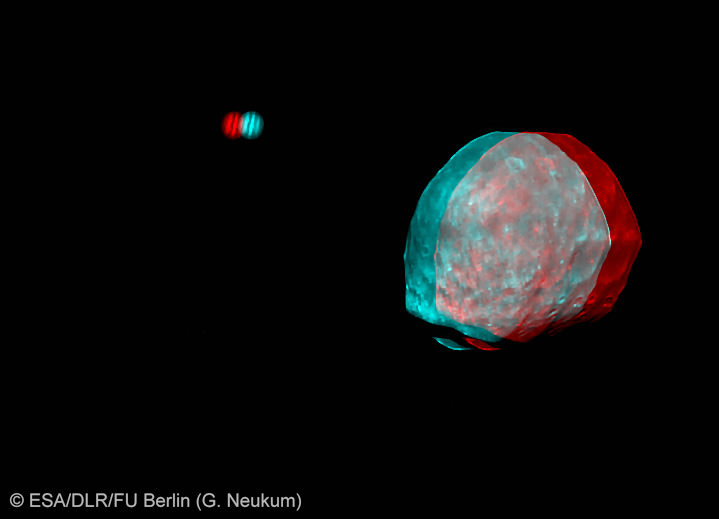
Video Caption: Phobos and Jupiter in Conjunction – taken from Mars orbit !
A movie of the 1 June 2011 Phobos–Jupiter conjunction made by combining a sequence of 100 images of the encounter taken by the High Resolution Stereo Camera on ESA’s Mars Express orbiter. Mars Express is searching for safe landing zones on Phobos for Russia’s Phobos-Grunt lander blasting off on November 9. Credits: ESA/DLR/FU Berlin (G. Neukum)
3 D images of Phobos-Jupiter conjuction below
Update – Phobos-Grunt launch processing photo below
In just 7 days, Russia’s Phobos-Grunt sample return mission will blast off for Mars on November 9 on a daring mission to grab soil samples from the surface of the miniscule martian moon Phobos and return them back to Earth for analysis to give us breathtaking new insights into the formation and evolution of Mars, Phobos and our Solar System.
So, check out the amazing animation and 3 D stereo images of fish-like Phobos and banded Jupiter snapped by Europe’s Mars Express orbiter to get a bird’s eye feel for the battered terrain, inherent risks and outright beauty that’s in store for the Phobos -Grunt spaceship when it arrives in the Red Planet’s vicinity around October 2012. Whip out your red-cyan 3 D glasses – Now !
[/caption]
ESA’s Mars Express orbiter (MEX) was tasked to help Russia locate suitable and safe landing sites on Phobos’ pockmarked terrain. MEX was built by ESA, the European Space Agency and has been in Mars orbit since 2003.
To capture this impressive series of rare photos of Jupiter and Phobos in conjunction, Mars Express performed a special maneuver to observe an unusual alignment of Jupiter and Phobos on 1 June 2011.
Mars Express High Resolution Stereo Camera (HRSC) snapped a total of 104 images over 68 seconds when the distance from the spacecraft to Phobos was 11,389 km and the distance to Jupiter was 529 million km.
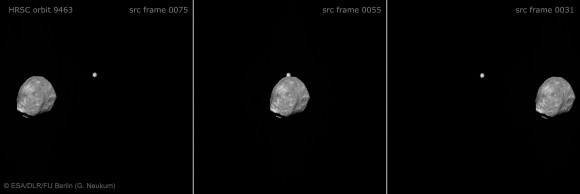
Enjoy the exquisite views of the bands of Jupiter and imagine exploring the deep pockets and mysterious grooves on Phobos – which may be a captured asteroid.
The camera was kept fixed on Jupiter, to ensure it remained static as Phobos passed in front and which afforded an improvement in our knowledge of the orbital position of Phobos.
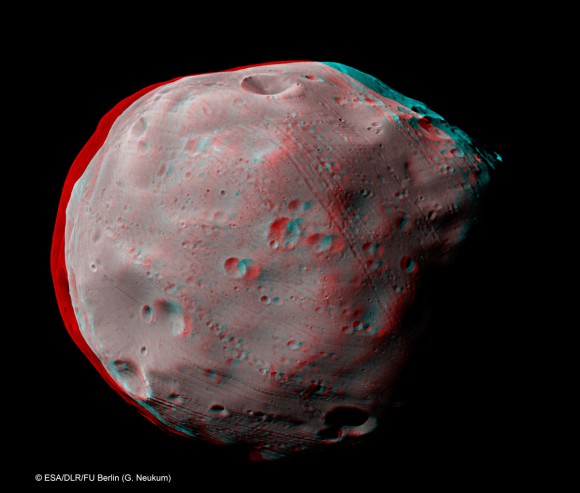
NASA’s twin Mars rovers Spirit and Opportunity have also occasionally photographed both of Mars’ moons to further refine their orbital parameters.
NASA’s Curiosity rover remains on track to liftoff for Mars on Nov. 25
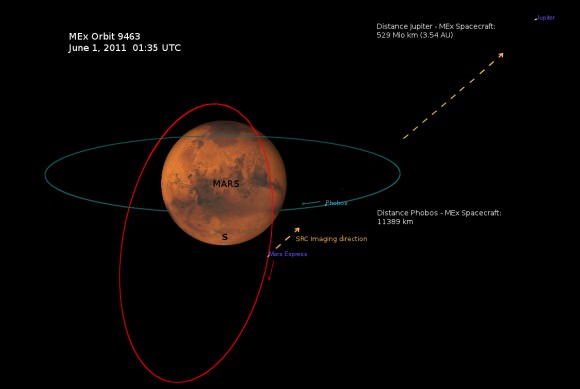
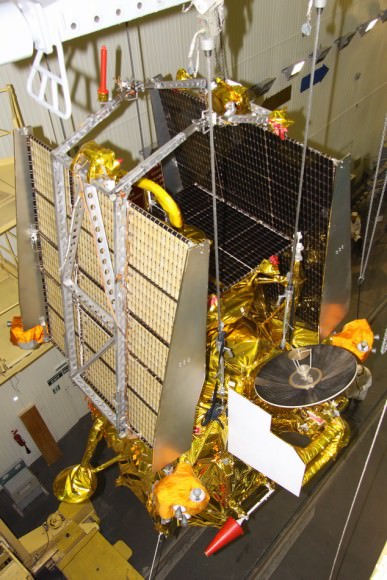
Read Ken’s continuing features about Phobos-Grunt here:
Russia Fuels Phobos-Grunt and sets Mars Launch for November 9
Phobos-Grunt and Yinghou-1 Arrive at Baikonur Launch Site to tight Mars Deadline
Phobos-Grunt: The Mission Poster
Daring Russian Sample Return mission to Martian Moon Phobos aims for November Liftoff
Are Black Holes Planet Smashers?
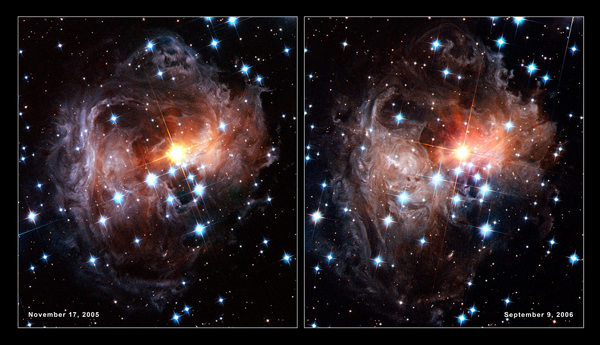
[/caption]
Some supermassive black holes are obscured by oddly shaped dust clouds which resemble doughnuts. These clouds have been an unsolved puzzle, but last week a scientist at the University of Leicester proposed a new theory to explain the origins of these clouds, saying that they could be the results of high-speed collisions between planets and asteroids in the central region of galaxies, where the supermassive black holes reside.
While black holes are a death knell for any objects wandering too close, this may mean even planets in a region nearby a black hole are doomed — but not because they would be sucked in. The central regions of galaxies just may be mayhem for planets.
“Too bad for life on these planets, ” said Dr. Sergei Nayakshin, whose paper will be published in the Monthly Notices of the Royal Astronomical Society journal.
In the center of nearly all galaxies are supermassive black holes. Previous studies show that about half of supermassive black holes are obscured by dust clouds.
Nayakshin and his team found inspiration for their new theory from our Solar System, and based their theory on the zodiacal dust which is known to originate from collisions between solid bodies such as asteroids and comets.
The central point of Nayakshin’s theory is that not only are black holes present in the central region of a galaxy, but stars, planets and asteroids as well.
The team’s theory asserts that any collisions between planets and asteroids in the central region of a galaxy would occur at speeds of up to 1000 km/sec. Given the tremendous speeds and energy present in such collisions, eventually rocky objects would be pulverized into microscopic dust grains.
Nayakshin also mentioned that the central region of a galaxy is an extremely harsh environment, given high amounts of deadly radiation and frequent collisions, both of which would make any planets near a supermassive black hole inhospitable well before they were destroyed in any collisions.
While Nayakshin said the frequent collisions would be bad news for any life that may exist on the planets, he added, “On the other hand the dust created in this way blocks much of the harmful radiation from reaching the rest of the host galaxy. This in turn may make it easier for life to prosper elsewhere in the rest of the central region of the galaxy.”
Nayakshin believes that a greater understanding of the origins of the dust near black holes is important to better understand how black holes grow and affect their host galaxy, and concluded with, “We suspect that the supermassive black hole in our own Galaxy, the Milky Way, expelled most of the gas that would otherwise turn into more stars and planets. Understanding the origin of the dust in the inner regions of galaxies would take us one step closer to solving the mystery of the supermassive black holes.”
The Asteroid That Fell To Earth: Meteorites from 2008 TC3 Still Giving Up Their Secrets
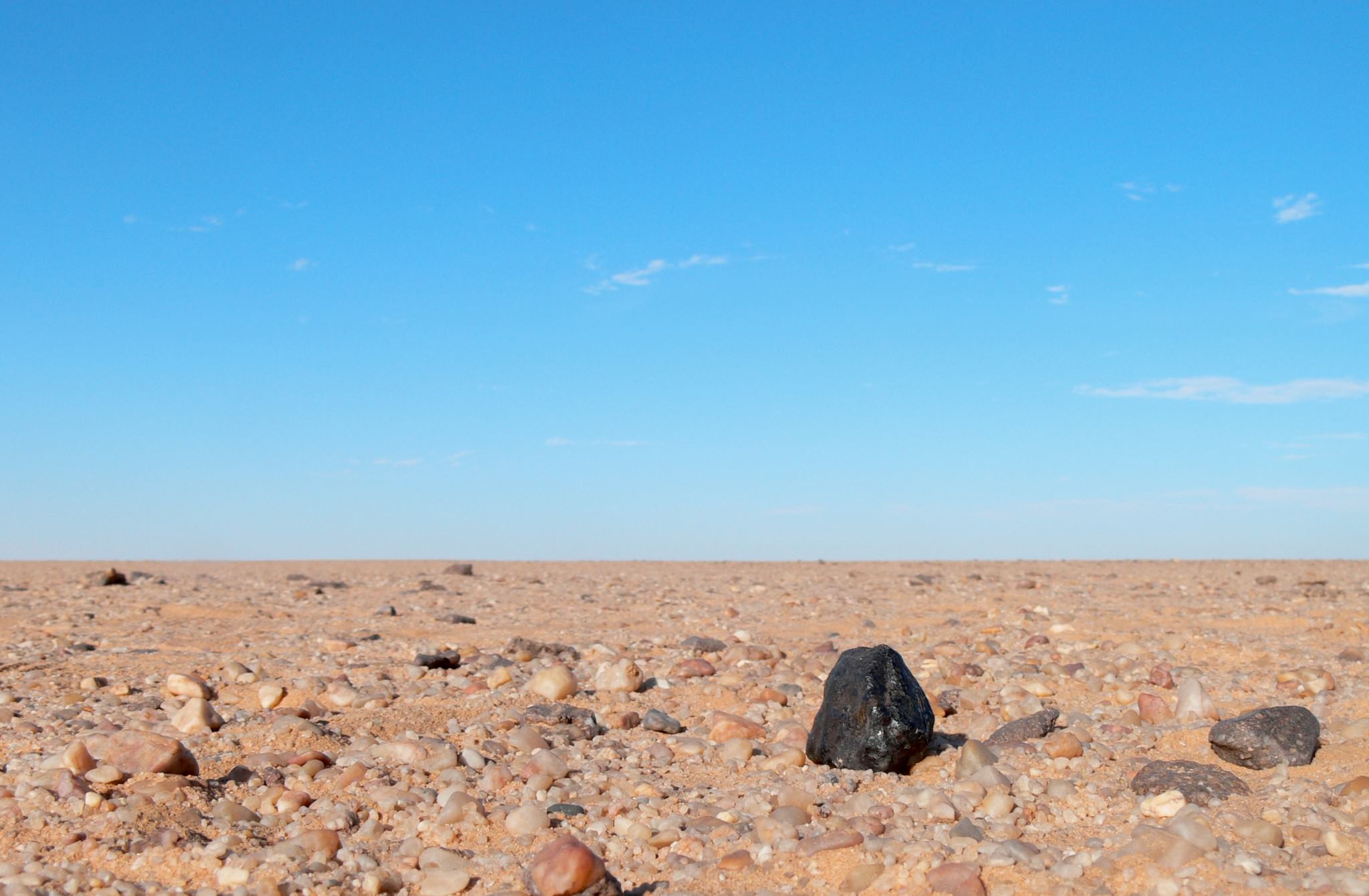
[/caption]
It was an unprecedented event: On October 6, 2008, asteroid 2008 TC3 was spotted by the Catalina Sky Survey Telescope in Arizona. Plotting its trajectory, astronomers knew the 80-ton rock was heading for a collision course with Earth. Just 19 hours later, 2008 TC3 streaked over skies of northern Sudan and then exploded about 37 km above the Nubian Desert. This was the first time an asteroid was predicted – and predicted correctly — to impact Earth. Luckily, it wasn’t big enough to cause any problems, and its path brought it over a remote area. But this presented scientists with an exciting and unparalleled opportunity to possibly study fragments of an asteroid that had been spectrally classified before striking Earth.
Shortly afterwards, expeditions led by Dr. Peter Jenniskens, a meteor astronomer from SETI and NASA’s Ames Research Center, and Mauwia Shaddad, a physicist at the University of Khartoum, collected nearly 600 pieces of the asteroid strewn over 29 kilometers of desert. Altogether the meteorites weighed less than 10 kilograms – all that was left of the 80-ton asteroid.
But these fragments that fell to Earth are revealing secrets about the asteroid belt and the early days of the solar system, says Dr. Jon Friedrich from Fordham University, one of the many different researchers who have been studying pieces of the fragments, now called the “Almahata Sitta” meteorites.
“We can now say the asteroid belt has lots of different types of materials that give little snapshots of conditions within the early solar system,” Friedrich told Universe Today. “We’ve seen that these asteroids haven’t changed a whole lot since the Solar System formed, so it speaks to the diversity of the chemistry and the processes that were acting on these small bodies in the early Solar System.”
Scientists agree that understanding the composition of the asteroid belt is crucial to how we might deal with a larger asteroid that might be heading directly towards Earth.
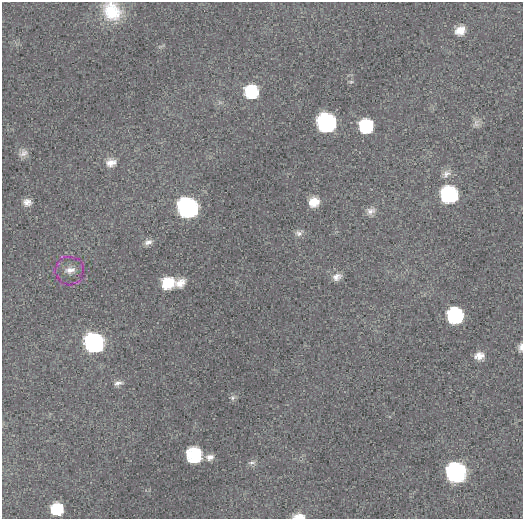
Although scientists have been able to study and catalog many thousands of meteorites and have also analyzed hundreds of asteroids in space, this is the first time a “fresh” chunk of an asteroid that has fallen to Earth as a meteorite — and been analyzed through spectroscopy while it was still in space — has been found so quickly after hitting Earth. These meteorites are the first to be unequivocally connected with its parent asteroid.
“It is amazing to be able to finally positively link an asteroid to a certain type of meteorite,” said Friedrich. “When we look at asteroids in space we are only looking at the outside, and the asteroid’s surface has changed from being in the environment of space. For the first time we can study the interior of an object we have seen the exterior of in space. That knowledge gives us a map as to how the exteriors of asteroids change. We can have a better understanding of the population of objects in space and their distribution in the solar system.”
About three-quarters of meteorites that are found on Earth are an “ordinary” kind of stony meteorites called chondrites. Analysis of the Almahata Sitta meteorites revealed a rare, carbon-rich type of meteorite called an ureilite. Ureilites are believed to come from a large organic–rich, primitive asteroid that had melted sometime in its past.
“These are a strange type of meteorite which are rather odd in the sense that it is an igneous rock, much like a volcanic rock here on Earth,” Friedrich said, “so this meteorite’s origin is from a magma, so they were surely melted at one point. That also means they are like rocks you might pick up on Earth, but they also contain what we might call relatively primitive materials also, like graphite, organic compounds and other things.”
And so ureilites, and in particular the Almahata Sitta meteorites, contain material from both primitive and evolved types of asteroids.
There are few ureilites in meteorite collections, which is another reason the Almahata Sitta meteorites are so interesting. They have an unusually fine-grained and porous texture, making the meteorites extremely fragile. The researchers think that is why Asteroid 2008 TC3 shattered high in Earth’s atmosphere.
Friedrich and a student at Fordham, Julianna Troiano, studied fragments of the meteorites using an inductively coupled plasma mass spectrometer, which specializes in looking at inorganic composition of rock.
“We found chemically that all the different pieces were indeed ureilites,” Friedrich said, “but one other interesting thing was that these don’t seem to have any evidence of terrestrial contamination at all, which is what you would expect from such a ‘fresh’ fall. Most ureilite meteorites have been found in Antarctica, and oftentimes, the Antarctic samples seem to have concentrations that are somewhat elevated in certain elements, such are rare Earth elements like lanthanum, cerium. But the Almahata Sitta meteorites don’t seem to have an obvious contamination signature.”
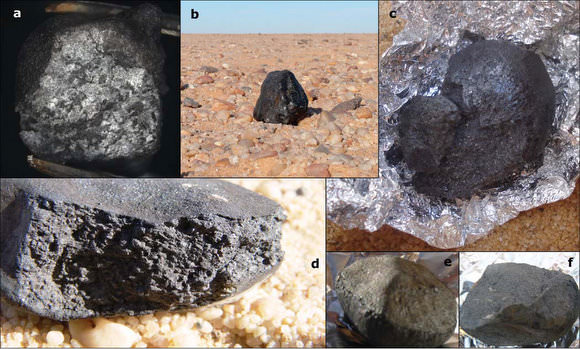
This allows the researchers to better explore the solar system’s makeup.
While chondrites normally have not been modified due to melting or differentiation of the parent asteroid — and researchers suspect they are not necessarily representative of typical asteroid parent bodies — ureilites normally do show signs of the parent body being melted.
So what has happened to an asteroid that is has somehow been heated to the point of “melting?”
The latest research on the Almahata Sitta meteorites reveal that the parent asteroid was probably formed through collisions of three different types of asteroids. This would also explain why the meteorites contain both evolved and primitive asteroid materials.
Dr. Julie Gayon-Markt from the Observatoire de la Cote d’Azur in France also recently provided more insight on the family of asteroids from which 2008 TC3 originated.
“Because falls of meteorites of different types are rare, the question of the origin of an asteroid harbouring both primitive and evolved characteristics is a challenging and intriguing problem,” said Gayon-Markt, who presented her findings at the Europlanet Science Conference in October. “A workable explanation for how asteroid 2008TC3 could have formed involves low velocity collisions between these asteroid fragments of very different mineralogies.
Gayon-Markt and her team also looked at the dynamics and spectroscopy of asteroids in the main asteroid belt to shed light on the origin of the Almahata Sitta fragments. “We show that the Nysa-Polana asteroid family, located in the inner Main Belt is a very good candidate for the origin of 2008 TC3,” she said.
Primitive asteroids, which are relatively unchanged since the birth of the Solar System, contain high proportions of hydrated minerals and organic materials. However, many other asteroids have undergone heating at some point, probably through the decay of radioactive materials, and the molten magma has separated into an iron core surrounded by a rocky mantle.
Friedrich and Gayton-Markt are just two of the researchers who are studying the Almahatta Sitta meteorites to try and garner a better understanding of our solar system, as well as figuring out more about the asteroid that fell to Earth in 2008.
“The study of these meteorites has been interdisciplinary and collaborative, and our work is just a small piece of a greater puzzle,” Friedrich said.
Sources: Interview with Jon Friedrich, Europlanet Conference
Note: Almahata Sitta, which is Arabic for “Station Six,” a train station between Wadi Halfa and Khartoum near where the fragments were found.
Asteroid Lutetia May Have A Molten Core
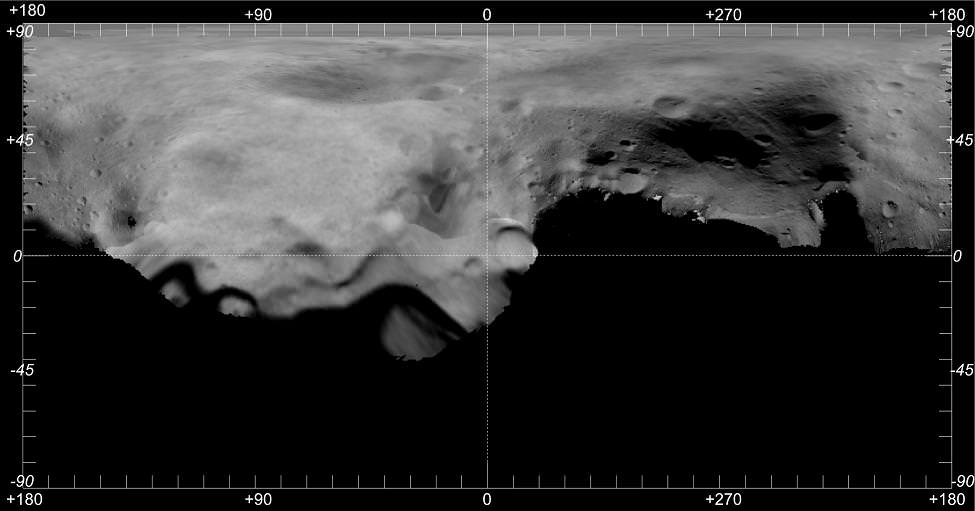
[/caption]
Way out in space, 282 million miles from home, the intrepid ESA Rosetta spacecraft is still busy, but had time to send us an unprecedented view of ancient asteroid Lutetia. On July 10, 2010, Rosetta flew past Lutetia and the results of the imaging revealed surface features which point to an astonishing history. This particular asteroid might not have a “heart of gold”, but it may very well have – or had – a molten interior.
Buzzing by at a speed of 54 000 km/hr and a closest distance of 3170 km, Rosetta took a series of high resolution images and returned them to an international team of researchers from France, Germany, the Netherlands and the United States. By closely examining the craters, cracks and surface, the team was able to determine that Lutetia survived a multitude of impacts – yet retained much of its original structure.
Lutetia fly-by from Science News on Vimeo.
Benjamin Weiss, an associate professor of planetary sciences in MIT’s Department of Earth, Atmospheric and Planetary Sciences, reports Lutetia may have a molten core and this finding shows a “hidden diversity” for known structures within the greater asteroid belt.
“There might be many bodies that have cores and interesting interiors that we never noticed, because they’re covered by unmelted surfaces,” says Weiss, who is a co-author on both Science papers and lead author for the paper in PSS. “The asteroid belt may be more interesting than it seems on the surface.”
Although the encounter was brief, images from the OSIRIS camera revealed some surface features which are believed to be up to 3.6 billion years old – while others appear to be 50-80 million. These ages can be estimated through impact events and the amount and distribution of ejecta. Some of the areas on Lutetia are heavily cratered, implying greater age, while others appear to be landslide events perhaps caused by nearby fractures. While most asteroids are small, light, and have smooth surfaces – Lutetia is different. It appears to be dense, yet relatively porous… a finding that points toward a “dense metallic core, with a once melted interior underneath its fractured crust.”
“We don’t think Lutetia was born looking like this,” says Holger Sierks, of the Max-Planck-Institut für Sonnensystemforschung, Lindau, Germany. “It was probably round when it formed.”
You’ve got to hand it to Rosetta. By being able to study these images, the many teams of scientists now have evidence for a theory developed last year by Weiss, Elkins-Tanton and MIT’s Maria Zuber. By studying chondrite meteorites, they’ve speculated these strongly magnetized samples most likely occurred in an asteroid with a melted, metallic core. If this theory proves to be correct, the Lutetia simply managed to dodge the proverbial bullets and developed with a molten interior.
“The planets … don’t retain a record of these early differentiation processes,” Weiss says. “So this asteroid may be a relic of the first events of melting in a body.”
According to MIT news, Erik Asphaug, a professor of planetary science at the University of California at Santa Cruz, studies “hit-and-run” collisions between early planetary bodies. He says the work by Weiss and his colleagues is a solid step toward resolving how certain asteroids like Lutetia may have evolved.
“We’ve had decades of cartoon speculation, and here’s speculation that’s anchored in physical understanding of how the interiors of these bodies would evolve,” says Asphaug, who was not involved in the research. “It’s like getting through the first 100 pages of a novel, and you don’t know where it’s leading, but it feels like the beginnings of a coherent picture.”
Another Rosetta stone?
Original Story Sources: ESA News Release and MIT News Release.

